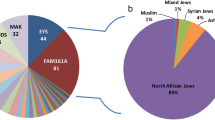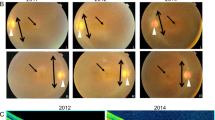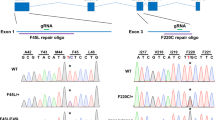Abstract
A recessive mutation in the tub gene causes obesity, deafness and retinal degeneration in tubby mice1–4. The tub gene is a member of a family of tubby-like genes (TULPs) that encode proteins of unknown function. Members of this family have been identified in plants, vertebrates and invertebrates4. The TULP proteins share a conserved carboxy-terminal region of approximately 200 amino-acid residues5. Here we report the analysis of the human gene TULP1, which is expressed specifically in the retina5. Upon analysing 162 patients with nonsyndromic recessive retinitis pigmentosa (RP) and 374 simplex cases of RP, we found two who were compound heterozygotes for mutations that cosegregated with disease in the respective families. Three of the mutations are missense changes affecting the conserved C-terminal region; the fourth mutation affects a splice donor site upstream of this region. Our data suggest that mutations in TULP1 are a rare cause of recessive RP and indicate that TULP1 has an essential role in the physiology of photoreceptors.
This is a preview of subscription content, access via your institution
Access options
Subscribe to this journal
Receive 12 print issues and online access
$209.00 per year
only $17.42 per issue
Buy this article
- Purchase on Springer Link
- Instant access to full article PDF
Prices may be subject to local taxes which are calculated during checkout
Similar content being viewed by others
References
Coleman, D.L. & Eicher, E.M. Fat (fat) and Tubby (tub): two autosomal recessive mutations causing obesity syndromes in the mouse. J. Hered. 81, 424–427 (1990).
Ohlemiller, K.K. et al. Cochlear and retinal degeneration in the tubby mouse. Neuroreport 6, 845–849 (1995).
Noben-Trauth, K., Naggert, J.K., North, M.A. & Nishina, P.M. A candidate gene for the mouse mutation tubby. Nature 380, 534–538 (1996).
Kleyn, P.W. et al. Identification and characterization of the mouse obesity gene tubby: A member of a novel gene family. Cell 85, 281–290 (1996).
North, M.A., Naggert, J.K., Yan, Y., Noben-Trauth, K. & Nishina, P.M. Molecular characterization of TUB, TULP1, and TULP2, members of the novel tubby gene family and their possible relation to ocular diseases. Proc. Natl. .Acad. Sci. USA 94, 3128–3133 (1997).
Knowles, J.A. et al. Identification of a locus, distinct from RDS-peripherin,for autosomal recessive retinitis pigmentosa on chromosome 6p. Hum. Mol. Genet. 31, 401–1403 (1994).
Shugart, Y.Y. et al. Fine genetic mapping of a gene for autosomal recessive retinitis pigmentosa on chromosome 6p21. Am. J. Hum. Genet. 57, 499–502 (1995).
Banerjee, P. et al. Co-segregation of a putative splice-site mutation in TULP1, a homologue of the mouse tub gene, in two Dominican pedigrees with autosomal recessive retinitis pigmentosa (RP14), Nature Genet. 18, 177–179 (1998).
Rosenfeld, P.J. et al. A null mutation in the rhodopsin gene causes rod photoreceptor dysfunction and autosomal recessive retinitis pigmentosa. Nature Genet. 1, 209–213 (1992).
Kumaramanickavel, G. et al. Missense rhodopsin mutation in a family with recessive RP. Nature Genet. 8, 10–11 (1994).
McLaughlin, M.E., Ehrhart, T.L., Berson, E.L. & Dryja, T.P. Mutation spectrum of the gene encoding the (3 subunit of rod phosphodiesterase among patients with autosomal recessive retinitis pigmentosa. Proc. Natl. Acad. Sci. USA 92, 3249–3253 (1995).
Danciger, M. et al. Mutations in the PDE6B gene in autosomal recessive retinitis pigmentosa. Genomics 30, 1–7 (1995).
Bayés, M. et al. Homozygous tandem duplication within the gene encoding the (3-subunit of rod phosphodiesterase as a cause of autosomal recessive retinitis pigmentosa. Hum. Mut. 5, 228–234 (1995).
Huang, S.H. et al. Autosomal recessive retinitis pigmentosa caused by mutations in the a subunit of rod cGMP phosphodiesterase. Nature Genet. 11, 468–471 (1995).
Dryja, T.P. et al. Mutations in the gene encoding the a subunit of the rod cGMP-gated channel in autosomal recessive retinitis pigmentosa. Proc. Natl. Acad. Sci. USA 92, 10177–10181 (1995).
Maw, M.A. et al. Mutation of the gene encoding cellular retinaldehyde-binding protein in autosomal recessive retinitis pigmentosa. Nature Genet 17, 198–200 (1997).
Gu, S.M. . et al. Mutations in RPE65 cause autosomal recessive childhood-onset severe retinal dystrophy. Nature Genet. 17, 194–197 (1997).
Berson, E.L. Retinitis pigmentosa. The Friedenwald Lecture, Invest. Ophthalmol. Vis. Sci. 34, 1659–1676 (1993).
Sandberg, M.A., Weigel-DiFranco, C., Rosner, B. & Berson, E.L. The relationship between visual field size and electroretinogram amplitude in retinitis pigmentosa. Invest. Ophthalmol. Vis. Sci. 37, 1693–1698 (1996).
Berson, E.L., Rosner, B., Sandberg, M.A. & Dryja, T.P. Ocular findings in patients with autosomal dominant retinitis pigmentosa and a rhodopsin gene defect (Pro23His). Arch. Ophthalmol. 109, 92–101 (1991).
Berson, E.L., Rosner, B., Sandberg, M.A., Weigel-DiFranco, C. & Dryja, T.P. Ocular findings in patients with autosomal dominant retinitis pigmentosa and rhodopsin, proline-347-leucine. Am. J. Ophthalmol. 111, 614–623 (1991).
Berson, E.L., Rosen, J.B. & Simonoff, E.A. Electroretinographic testing as an aid in detection of carriers of X-chromosome-linked retinitis pigmentosa. Am. J. Ophthalmol. 87, 460–468 (1979).
Kunkel, L.M. et al. Analysis of human chromosome-specific reiterated DNA in chromosome variants. Proc.Natl. Acad. Sci. USA 74, 1245–1249 (1977).
Orita, M., Iwahana, H., Kanazawa, H., Hayashi, K. & Sekiya, T. Detection of polymorphisms of human DNA by gel electrophoresis as single-strand conformation polymorphisms. Proc. Natl. Acad. Sci. USA 86, 2766–2770 (1989).
Author information
Authors and Affiliations
Corresponding author
Rights and permissions
About this article
Cite this article
Hagstrom, S., North, M., Nishina, P. et al. Recessive mutations in the gene encoding the tubby-like protein TULP1 in patients with Retinitis pigmentosa. Nat Genet 18, 174–176 (1998). https://doi.org/10.1038/ng0298-174
Received:
Accepted:
Issue Date:
DOI: https://doi.org/10.1038/ng0298-174
This article is cited by
-
Whole-genome and dispersed duplication, including transposed duplication, jointly advance the evolution of TLP genes in seven representative Poaceae lineages
BMC Genomics (2023)
-
Molecular basis of retinal remodeling in a zebrafish model of retinitis pigmentosa
Cellular and Molecular Life Sciences (2023)
-
Tulp1 deficiency causes early-onset retinal degeneration through affecting ciliogenesis and activating ferroptosis in zebrafish
Cell Death & Disease (2022)
-
βA3/A1-crystallin regulates apical polarity and EGFR endocytosis in retinal pigmented epithelial cells
Communications Biology (2021)
-
Distinct mutations with different inheritance mode caused similar retinal dystrophies in one family: a demonstration of the importance of genetic annotations in complicated pedigrees
Journal of Translational Medicine (2018)



